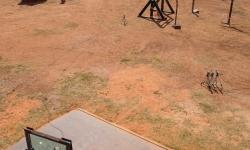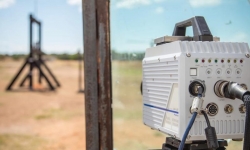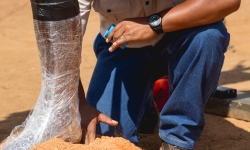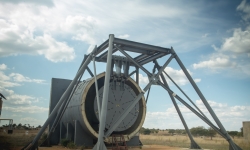Detonics, ballistics and explosives laboratory
The CSIR’s Detonics, ballistics and explosives laboratory (DBEL) is a uniquely equipped facility, outside of the City of Tshwane, where experimentation is conducted to determine the impact of blast effects on soldiers, vehicles and infrastructure.
The facility is used to develop protective technologies, define optimal mobility solutions, evaluate products or systems to assist with procurement decision-making and, ultimately, ensure effective yet safe military operations.
DBEL is licensed to handle explosive events of net explosive content from less than 100 g, up to 50 kg – typically from small arms fire up to large explosive devices. To cover different test types, DBEL has facilities for water-borne explosives, grenade launchers and mine detection – supported by the necessary explosive magazines, explosive ordnance disposal facilities, plus high-speed photography capabilities and a safe shelter for viewing of blast tests.
DBEL is the only national facility for validation of vehicle protection against landmines and improvised explosive devices (IEDs). A considerable amount of research focuses on characterisation of IEDs, which are increasingly used in modern warfare and for which limited protection solutions and standards exist. Using projectile impact, such devices have extreme penetrative force – even through armoured protection.
DBEL is also used to develop specifications – and check delivered goods against specifications. This avoids the intake of inferior, inefficient – even dangerous or defective – products and prevents loss of lives and loss of millions of rands of defence force funds.
Through this facility, the CSIR has developed and contributed to both international and local protection standards and is able to provide a training platform for explosives experts.
Protective technologies and disruptor devices have also sparked commercial interest and aside from establishing patents, have also created opportunity for transfer to industry and establishment of manufacturing businesses.
Explosive science
The CSIR’s measurement methodology is based on comparing various explosives and munitions in terms of blast wave characteristics. Elements of the research include analyses of pressure, stress, load or force, velocity, acceleration, displacement and impulse.
The acquisition of data during explosive tests is accomplished by the integration of various sensors, medium, high and ultra-high speed cameras (capturing up to 2 million frames per second), various data acquisition systems and X-ray systems. However, not all research requires the detonation of explosives. For instance, a device can be inspected dynamically or non-destructively through the use of X-ray facilities.
Ultra-high-speed photography and the flash X-ray system are used for ultra-fast diagnostics of explosive events. These diagnostic tools capture events in nanoseconds.
Chemicals laboratory
The CSIR has an in-house laboratory for chemical formulation and characterisation of energetic materials. The purpose of the laboratory is to enable chemical formulations and perform chemical analysis to enhance conventional energetic materials and analyse unconventional energetic materials such as IEDs. Chemical analysis is used to identify the contents, composition and quality of the materials used in product development, manufacturing and in-service support activities.
Analytical methods available in this laboratory for the analysis of explosives include:
- Chemical tests (based on colour reaction);
- Chromatographic methods such as thin layer chromatography;
- Gas chromatography mass spectrometry and;
- Differential thermal analyses.
The characterisation of explosives is concerned with measuring and evaluating chemical and structural basis data, both of new substances formulated in-house and of commercially available substances prior- and post-detonation.






